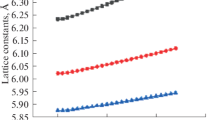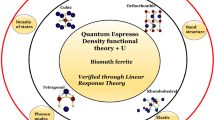Abstract
The electric field effects on the structure, decomposition mechanism, and stability of crystalline lead styphnate have been studied using density functional theory. The results indicate that the influence of external electric field on the crystal structure is anisotropic. The electric field effects on the distance of the Pb–O ionic interactions are stronger than those on the covalent interactions. However, the changes of most structural parameters are not monotonically dependent on the increased electric field. This reveals that lead styphnate can undergo a phase transition upon the external electric field. When the applied field is increased to 0.003 a.u., the effective band gap and total density of states vary evidently. And the Franz-Keldysh effect yields larger influence on the band gap than the structural change induced by external electric field. Furthermore, lead styphnate has different initial decomposition reactions in the presence and absence of the electric field. Finally, we find that its sensitivity becomes more and more sensitive with the increasing electric field.







Similar content being viewed by others
References
Behler KD, Ciezak-Jenkins JA, Sausa RC (2013) J Phys Chem A 117:1737–1743
Xu XJ, Zhu WH, Xiao HM (2007) J Phys Chem B 111:2090–2097
Qiu L, Zhu WH, Xiao JJ, Xiao HM (2008) J Phys Chem B 112:3882–3893
Liu Y, Gong XD, Wang LJ, Wang GX (2011) J Phys Chem C 115:11738–11748
Liu Y, Zhang L, Wang GX, Wang LJ, Gong XD (2012) J Phys Chem C 116:16144–16153
Zhu WH, Xiao HM (2011) J Phys Chem C 115:20782–20787
Ge NN, Wei YK, Ji GF, Chen XR, Zhao F, Wei DQ (2012) J Phys Chem B 116:13696–13704
Manaa MR, Fried LE (2012) J Phys Chem C 116:2116–2122
Pravica M, Liu Y, Robinson J, Velisavljevic N, Liu ZX, Galley M (2012) J Appl Phys 111:103534
Pravica M, Galley M, Park C, Ruiz H, Wojno J (2011) High Press Res 31:80–85
Auzanneau M, Roux M (1995) Propellants Explos Pyrotech 20:96–101
Skinner D, Olson D, Block-Bolten A (1997) Propellants Explos Pyrotech 23:34–42
Talawar MB, Agrawal AP, Anniyappan M, Wani DS, Bansode MK, Gore GM (2006) J Hazard Mater 137:1074–1078
Badgujar DM, Talawar MB, Asthana SN, Mahulikar PP (2008) J Hazard Mater 151:289–305
Talawar MB, Sivabalan R, Mukundan T, Muthurajan H, Sikder AK, Gandhe BR, Rao AS (2009) J Hazard Mater 161:589–607
Zhi C, Cheng X, Zhao F (2010) Propellants Explos Pyrotech 35:555–560
Zhi C, Cheng X, Zhao F (2012) Chinese J Struct Chem 31:1263–1270
Türker L (2009) J Hazard Mater 169:454–459
Zeman S (2006) J Hazard Mater 132:155–164
Zeman S, Pelikan V, Majzlik J (2006) Cent Eur J Energ Mater 3:27–44
Zeman V, Koci J, Zeman S (1999) Chinese J Energ Mater 7:127–132
Zeman V, Koci J, Zeman S (1999) Chinese J Energ Mater 7:172–175
Zeman S, Koci J (2000) Chinese J Energ Mater 8:18–26
Koci J, Zeman V, Zeman S (2001) Chinese J Energ Mater 9:60–65
Keshavarz MH, Pouretedal HR, Semnani A (2009) J Hazard Mater 167:461–466
Keshavarz MH (2008) J Hazard Mater 153:201–206
Keshavarz MH, Pouretedal HR, Semnani A (2008) Indian J Eng Mater Sci 15:505–509
Keshavarz MH (2008) Indian J Eng Mater Sci 15:281–286
Zhu WH, Xiao HM (2009) J Phys Chem B 113:10315–10321
Wang L, Zhang YZ, Zhang YF, Chen XS, Lu W (2010) Nanoscale Res Lett 5:1027–1031
Baei MT, Peyghan AA, Moghimi M (2012) J Mol Model 18:4477–4489
Baei MT, Peyghan AA, Moghimi M, Hashemian S (2013) J Mol Model 19:97–107
Chattopadhyaya M, Alam MM, Chakrabarti S (2012) Phys Chem Chem Phys 14:9439–9443
Jissy AK, Datta A (2012) ChemPhysChem 13:4163–4172
Calvaresi M, Martinez RV, Losilla NS, Martinez J, Garcia R, Zerbetto F (2010) J Phys Chem Lett 1:3256–3260
Pierce-Butler MA (1982) Acta Crystallogr. Sect B 38:3100–3104
Perdew JP, Wang Y (1992) Phys Rev B 45:13244–13249
Perdew JP, Chevary JA, Vosko SH, Jackson KA, Pederson MR, Singh DJ, Fiolhais C (1992) Phys Rev B 46:6671–6687
Delley B (1990) J Chem Phys 92:508–517
Delley B (2000) J Chem Phys 113:7756–7764
Zhu WH, Xiao HM (2010) Struct Chem 21:657–665
Kuklja MM, Stefanovich EV, Kunz AB (2000) J Chem Phys 112:3417–3423
Kuklja MM, Kunz AB (2000) J Appl Phys 87:2215–2218
Luty T, Ordon P, Eckhardt CJ (2002) J Chem Phys 117:1775–1785
Faust WL (1989) Science 245:37–42
Acknowledgments
This work was supported by the National “973”project, the Natural Science Foundation of Chongqing (Grant No. cstc2011jjA50013), the Scientific and Technological Research Program of Chongqing Municipal Education Commission (Grant No. KJ111310), and the State Key Laboratory of Explosion Science and Technology (Grant No. ZDKT08-01, Grant No. YBKT10-03).
Author information
Authors and Affiliations
Corresponding authors
Rights and permissions
About this article
Cite this article
Li, Z., Huang, H., Zhang, T. et al. First-principles study of electric field effects on the structure, decomposition mechanism, and stability of crystalline lead styphnate. J Mol Model 20, 2072 (2014). https://doi.org/10.1007/s00894-014-2072-4
Received:
Accepted:
Published:
DOI: https://doi.org/10.1007/s00894-014-2072-4




